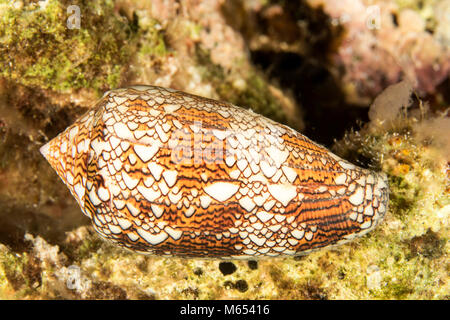

There is no further investment in parental care after eggs are laid, as is the case for most marine invertebrates. Range age at sexual or reproductive maturity (male) 6 to 12 months.Range age at sexual or reproductive maturity (female) 6 to 12 months.Range time to independence 15 to 25 days.Breeding season Between April and September when the waters are warm.Breeding interval Geographic cone snails breed once a year.gonochoric/gonochoristic/dioecious (sexes separate).After mating, the female lays her egg capsules on a smooth, hard surface, where they develop into larvae in twenty days. Sexual maturity may occur between 6 to 12 months. No information is available as to whether mating occurs singly or at multiple times across the lifespan. Two to three days later, the female lays several capsules eggs on a hard surface. This position is maintained for at least 15 minutes before the male retracts its verge. It inserts about 2/3 of a ribbon-like organ called the verge (analogous to a penis) into the female’s opening near the anal notch. Some researchers hypothesize that male cone snails may exhibit territoriality to ensure access to potential mates.ĭuring copulation, the male mounts the female using its foot. Published observations on reproductive behavior were made in aquaria, and direct observations on ritual courtships or competition for a mate in the wild is lacking. Planktonic survival rate is affected by weather and oceanographic factors such as water temperature, salinity, and ocean currents, as well as abundance of secondary consumers in the water column.

Only a low percentage of cone snail larvae survive to metamorphose into benthic juveniles, and even fewer survive to reach adulthood. The larval diet is unknown, but assumed to be smaller plankton. After twenty days, the transparent shells and bodies are visible, and they break from their capsules and drift in the plankton as meroplanktonic veliger larvae (a temporary zooplanktonic stage of the lifecycle). The eggs incubate within their capsule for 10 to 15 days before maturing into the larval stage. After the mating ritual, clusters of egg sacs (about 40 eggs per sac) are extruded and attached on a suitable hard surface. Very little is known of the cone shell’s natural history from neoteny to adulthood. Venom glands produce deadly toxins and digestive enzymes, and these are injected into the snail’s prey through the radular tooth. The cone snail uses a elaborately scuplted, hollow radular tooth (housed in the proboscis) as a harpoon to incapacitate its prey. The most obvious features of the geographic cone snail are the foot, which extends from the aperture two small eyes borne on eyestalks, and two features associated with their feeding habits: the proboscis, an extendable protrusion in the oral region that expands to swallow its prey, and the siphon, an extension of the mantle tissue, used for chemoreception of its prey. This protein covering gives the cone a roughened appearance. The shell is covered with a thin yellowish layer of protein-based material called the periostracum, forming tufts on the spire, on the spiral rows, and along the body whorl, following the sculpture of the shell. The outer shell’s coloration ranges from ground colors of white, cream, or rose pink overlain with brown or red mottled patterns arranged in horizontal spirals along the body whorl. The body whorl terminates in an elongated aperture that has a width of about 1/3 of the overall shell width. The spire is concave with smooth sutures and a prominent point at the protoconch apex. The shell spire is obconical (having a length of less than or equal to 10% of the entire structure) featuring coronation (small bumps) at and above the shoulder along the edges of the larger whorls. Range depth 0 to 200 m 0.00 to 656.17 ftĪ calcareous, smooth shell covers the mollusk’s soft body.They are less commonly found in deeper waters. Their surrounding habitat includes living or fragmented coral reefs, and sandy regions within tidal zones. Geographic cone snails are most commonly found in the sublittoral epipelagic zone. Rare sightings (and recorded fatalities) have also been reported in New Caledonia. The geographic cone snail, Conus geographus, is indigenous to the tropical and subtropical Indo-Pacific regions, found specifically along the northern shores of Australia, ranging from the west coast (Brisbane, Queensland), central (Darwin, Northern Territory), and east coast (Exmouth, Western Australia).


 0 kommentar(er)
0 kommentar(er)
